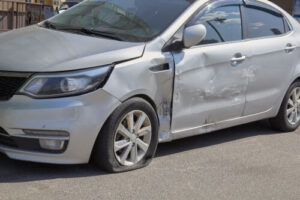Call 24/7 801-810-9999
Book a Consultation
Find out why so many clients appreciate the amount of work we put into their case.
"*" indicates required fields

Car accidents can be terrifying events regardless of their severity.
At the small end of the scale, a pedestrian whose foot was injured when a car ran over it can experience terrible pain as well as potentially severe foot injuries, accompanied by the thought that she might not be able to walk properly again.
At the opposite end of the spectrum, highway crashes on I-15 can have fatal consequences for multiple vehicles, including those of respondents who just want to help.
The aftermath of car accidents is always an unpredictable scene, where situations can escalate or stabilize at a moment’s notice. In the event of an automobile accident, Utahn police officers serve to ensure safety and security for an otherwise chaotic and dangerous event.
But a police officer’s capacity to aid in the event of a car accident hinges on their ability to get informed of it and arrive as first responders. This is the reason why, after you are involved in a vehicular accident – or even if you just witnessed one – it is your duty to inform the police.
When do you have to call the police after a car accident? Ideally, you do it as soon as possible, though with a few other priorities taking precedence over contacting them.
Before the police arrive, and indeed, before even calling the police, you need to make sure that everyone involved in a car accident is safe, starting with you. This means moving yourself and anyone you can out of harm’s way and, if possible, moving your vehicle off the road.
Note that you are legally required to provide reasonable aid to anyone caught in an accident with your car. Besides first-aid, that means offering transport to get medical treatment if apparently necessary or if an injured party makes a request to do so.
Failure to provide such aid is classified under the law as a Class C misdemeanor.
However, try not to move anyone unconscious unless you are trained to do so or unless there is an immediate threat to them, such as fire. Unconscious people are difficult to extract safely, and you can do more harm than good without proper training and experience.
The law states you have to provide reasonable aid, with stress on reasonable. Do not attempt to take action you know you are incapable of properly executing.
Once police do arrive, try to cooperate with them to the best of your ability. Even if police officers are trained to handle these kinds of situations, they might not have a good idea of what happened until they are informed by people who were actually at the scene.
If you haven’t already done so, exchange information with other parties who were involved. You want to get the other driver’s name, address, vehicle registration details, vehicle insurer, and the insurer’s contact information.
If you can get it, it would also be helpful to have the other driver’s phone number as well since that would allow you the most convenient way to contact them when needed. For the most part, however, the above information is all that they need to provide according to Utah law.
You can also ask for driver’s license information, as the law compels people to present it on request after an accident. Though it’s easier to get information from another person when a police officer is present, as people are more likely to work together when authority is around.
Keep in mind that you have to get information from all drivers involved. You are, of course, expected to provide the same information to other parties as well.
As mentioned above, police officers will want to take statements from everyone involved in an attempt to piece together what happened. When they talk with you, provide as much information as you can, but do not say anything that suggests you are at fault.
Even suggesting in passing that you may have done something wrong can lead other opportunistic parties to agree in an attempt to reduce the blame they shoulder.
For that matter, try not to assign fault to other parties either. Blaming another person for the accident may give the impression that you are not being objective regarding what happened.
The general rule here is to tell the police what happened but not what people did. For example, you can describe the movement of the vehicles.
There is a chance that another party will provide misleading or biased information where they try to assign blame, but as we said, this can give the wrong impression about them. If someone does try to shift the blame to you, calmly disagree with them, and do not engage in blame.
Police reports are generally considered to be a reliable source of information for any insurance claims and legal proceedings. Officers are assumed to be objective with regard to a car crash they aren’t involved in, and so their reports are considered the official account of events.
Police officers in Utah will either draft their police reports at the scene or at a later time after interviews with involved parties. Most police officers do so within a couple of days of the accident.
Utah law requires police officers to file electronic copies of reports on car accidents they investigate within ten days of concluding the investigation. Part of their job is also to disclose the report to those involved, those injured, and those representing such parties.
The police report is not the only report of the accident that might exist. The same section of the Utah Code specifies that drivers involved may be required to accomplish their own car accident reports in the event of death, injury, or property damage amounting to $2,5000 or more.
Witnesses to the accident may also be required to do the same. Here is the typical information you will find on an accident report:
This is not an exhaustive list of information found on an accident report. What makes it on paper can vary with the context of the accident itself and even with the officer writing the report.
For instance, some reports might include impounding information if vehicles were towed from the scene, while others might include the officer’s opinion noted down. Still, you can mostly expect that the report includes as much direct information from the accident as possible.
Finally, when you obtain your copy, keep in mind that because accident reports contain the personal information of multiple parties, they are considered classified information. You are provided access to that information because you are directly involved with the event.
The law will protect you and anyone else to whom a copy of the information was furnished. However, revealing the information to any unprivileged party is illegal.
Civil lawsuits are intended to be discussed, as the name implies, civilly between the parties involved.
If you need help with your car accident settlement, work with our professional personal injury attorneys at Valley Law Accident and Injury Lawyers. From securing the police report to building your strongest possible case from it, we will fight for the best claim you can get.
Lead attorney Brigham Richards brings over ten years of expertise in personal injury law to the table so you can get the compensation you deserve. His personal approach to clients ensures that your needs are placed first.
Call us today at 801-810-9999 or reach out to us via our online contact form found here. We offer a no-cost, no-obligation consultation, and we will not charge you until after we have won your case for you.
Get in touch


2021 and 2022 Gold Winner for Top Law Firm by Salt City Best
Call 24/7 801-810-9999